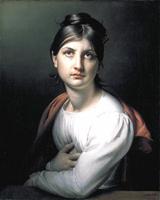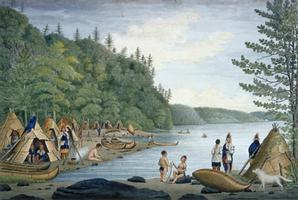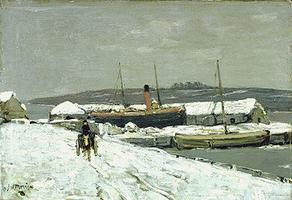Art
The Indigenous people of Canada excelled in all forms of art (see Indigenous Art; Inuit Art; Northwest Coast Indigenous Art; Prehistory), but their great achievements are beyond the scope of this article. Early Canadian art in the European tradition cannot be separated from European artistic production of the same period. From the time they arrived in Canada, French colonists attempted to reproduce an architectural environment that reminded them of their motherland (see also Architecture). Before launching more ambitious projects, they erected a system of protection used in Europe since the late Middle Ages: the fortified manor. Early construction at Port-Royal, Champlain's residence in Québec City (1608), and Maisonneuve's Pointe-à-Callières fort in Montréal (1642) were built on these lines, though in materials such as wood which were available and easily worked. Construction methods borrowed nothing from indigenous habitations.
Objects of curiosity as well as of conquest, the Indigenous people of the New World were first depicted on maps by illustrators who had no direct knowledge of their subject. They reflected more the traditional preconceptions about peoples who were supposed to inhabit the far reaches of the known world than the actual accounts of the discoverers, who themselves were not without prejudice. Books about Canada were more accurate. The works of Samuel de Champlain, for instance, were illustrated by a few engravings based on Champlain's drawings, which gave a relatively good view of some aspects of Huron life, such as hunting, healing rituals and funerary practices. The portraits of Inuit painted by John White during Martin Frobisher's expedition are astonishingly accurate. Drawings by the Jesuit Louis Nicolas, now known as the Codex canadensis, took their inspiration from François Du Creux's Historia Canadensis ... (1664), but they added so many details to their models that they contribute immensely to knowledge of the first inhabitants of Canada, particularly the Algonquians.
Population growth, while much slower than in New England during the same period, soon made it necessary to construct more permanent dwellings. Towns began to flourish. Québec City had taken shape by the end of the 17th century, its major buildings already in locations they occupied during the French regime (to 1760). Cathedrals, convents and the headquarters of the governor and the intendant occupied the best land on Cap Diamond or, as it was then called, "la haute ville." The commercial Lower Town developed around the small Notre-Dame-des-Victoires Chapel (1688), in front of which a bust of the king graced a small square. Built according to plans drawn up by engineers Claude Baillif, Levasseur de Néré and Chaussegros de Léry, if not by professional architects, these buildings were solid constructions in stone, recalling the style of provincial France of the same period.
Founded a little later, Montréal followed a similar development. Maisonneuve's old fort was abandoned, and the city spread out along the St Lawrence River between the parish church, almost where Notre-Dame is today, and the Bonsecours Chapel, construction of which began in 1657. A fortified wall was built in an attempt to establish the town boundaries. A striking example of 18th-century military architecture, the massive fortress of Louisbourg on Cape Breton Island was designed by Jean-François de Verville to follow Sébastien Le Prestre de Vauban's system of fortifications and proved extremely costly to build. After 1960 it was rebuilt by Parks Canada in meticulous detail.
At the same time as this urban development was taking place, the seigneurial system was creating rural habitations along the river. Villages, the centre of which was always the parish church, were slow to develop. By the 18th century the countryside was dotted with churches that imitated the splendid town churches, which in turn were reminiscent of French provincial churches. Québec's Notre-Dame and the churches of the Jesuits and Récollets had a determining influence on these rural churches. Houses around Québec, in contrast, resembled those on Norman farms, and houses elsewhere recalled those found in Maine, Perche or Anjou, the native regions of most of the colonists. In contrast to New England architecture, stone and wood were used frequently, but brick was never employed.
By the late 17th century, sculptors were commissioned to adorn the churches with high altars in carved and gilded wood. Unlike church paintings, which were created on canvas and could be rolled up and transported by ship, the more cumbersome sculptures were produced locally by tradesmen who passed their knowledge down through the generations from master to apprentice. The most famous were the Levasseurs and Baillairgés of Québec, Philippe Liébert and, later, Louis Quévillon of Montréal. In style these sculptors were catching up to the prevalent trends in France - Louis XV, rococo, neoclassical - though with some delay owing to the difficulties in communication between the metropolis and the colony (see also sculpture).
France's mercantilism made it more difficult for painting to develop. With the exception of ex-voto paintings (see Votive Painting) and a few portraits of nuns (especially posthumous portraits) and officers done in New France, paintings dating from the French regime were imported. Frère Luc might be considered an exception, but he spent only 15 months in Canada. On one level these difficult conditions contributed to the quality of early painting in Canada, for they have a spontaneity and naïvety which are not always found in sculpture.
The British Conquest in 1760 did not immediately alter the face of architecture. Buildings damaged during the war were reconstructed and churches were built according to traditional plans, now slightly more formalized under the influence of Abbé Conefroy's plan for the Boucherville Church (1801). Later, under the influence of Jérôme Demers, a professor of architecture at the seminary in Québec, architects such as his pupil Thomas Baillairgé became receptive to French neoclassicism. Demers was a devoted follower of French architects like Vignole and Blondel.
The arrival of the British in North America had an immediate effect on painting. English officers trained at the Military Academy in Woolwich showed their enthusiasm for the Canadian landscape by producing many topographic paintings and ornamental landscapes which were often engraved in London. Thomas Davies was one of the earliest and the most famous of these English watercolour artists. His works have a freshness that is not found in those of Richard Short or James Pattison Cockburn, which are of a more documentary nature.
New waves of colonists had a profound influence on the arts. Like the French before them, the British tended to prefer the style which they knew best, Georgian, which for a long time thereafter symbolized allegiance to the British Crown. The Loyalists brought art objects and ideas with them from the US, including silver, engravings and paintings, as well as the memories of the architecture of various regions. By 1800 an expanding economy favoured growth of a middle class and several garrison communities. Portraits of merchants and their families, of soldiers, government officials and the clergy were in demand. After spending 14 years as a portrait artist in the US, Robert Field lived for 8 years in Halifax, where he continued in this genre; his English background and training made him a polished painter, familiar with the styles and techniques fashionable during this period.
The turn of the century saw the beginning of what is sometimes called the Golden Age of Québec painting. New stimuli became available; Québec artists went to Europe to study, and European artists continued to arrive in Canada. François Beaucourt, Antoine Plamondon and Théophile Hamel belonged to the former group, William Berczy and Cornelius Krieghoff to the latter. Joseph Légaré, however, never set foot in Europe; his interest in art and collecting developed parallel to his pictorial records of landscapes, dramatic events in the history of Québec and occasional bursts of pictorial fantasy.
Stylistically, European influence in Canada remained strong, but subject matter in painting broadened. In small, precise paintings Peter Rindisbacher showed what it meant to a young Swiss to sail into Hudson Bay and settle in the Red River Colony. Working out of Upper Canada, Paul Kane can really be called an artist/adventurer; in 1845 he was inspired by the American George Catlin to make a journey across Canada, recording Indians, the portages and the scenery in many sketches and paintings, still small in format and stylistically dense.
As in the US during the first half of the 19th century, Canada too was sensitive to a variety of architectural styles. British architects such as John Wells (Bank of Montreal, 1848) and John Ostell (Notre-Dame-de-Grace, 1851) used a neoclassical style in their buildings in Montréal, whereas James O'Donnell and his patrons favoured the neogothic for the Church of Notre-Dame (1829) in the same city. Both stylistic tendencies were also employed in Halifax, Kingston and Toronto.
In 1796 York (named Toronto in 1834) became the capital of Upper Canada. Growing prosperity attracted portrait painters such as G.T. Berthon, landscape painters such as Robert R. Whale, and explorers and genre painters such as William HIND, whose sketches are as interesting as his paintings. All were precursors of the more important Lucius O'Brien, John A. Fraser and Allan Edson, who, like American painters of the same period, favoured a romantic approach to landscape, with richer brushwork and subtler use of colour. These men were the first to attempt to convey on canvas the majesty of the Rocky Mountains or the atmospheric effects of the Atlantic Coast.
With Confederation in 1867, the urge to express a new sense of Canada as a unified country was felt in the arts. The Parliament Buildings in Ottawa were completed in 1866; Robert Harris was commissioned to paint his famous group portrait, The Fathers of Confederation, in 1883. The Royal Canadian Academy of Arts and the National Gallery of Canada were created in 1880 by the Marquess of Lorne (see Artists' Organizations).
Following a brief slowdown caused by the economic crisis in 1873, Canadian architecture grew at an unprecedented rate and, in the East at least, reflected the evolution from an essentially rural to an industrial economy. The period 1873-1914 witnessed a new taste for historicism, as if each architect felt the need to compete with his colleague in his ability to quote some architectural elements of the past: Gothic spires or windows were linked to French mansards, Italianate elements with Tudor styles. Public buildings (churches, railway stations such as Windsor Station in Montréal, "château"-style hotels such as the Frontenac in Québec City and the Empress in Victoria) as well as domestic architecture, particularly in rural Ontario, showed this eclecticism. In the midst of this "revival" frenzy a new feeling for modern architectural space, and innovative materials such as cast iron, glass and, later, cement appeared, leading to basic structural changes in Canadian architecture.
At the turn of the century, painting was marked by such major figures as James Wilson Morrice, the father of Canadian modernism; Ozias Leduc, who divided his time between ambitious church decorations and exquisite still lifes and landscapes of St-Hilaire; Homer Watson, who presented a more intimate vision of the Canadian landscape; and George Reid and Paul Peel, who were closer to the academic tradition. Nevertheless, with the exception of Morrice, who was an avid admirer of Matisse as early as 1908, and perhaps William Brymner, the influence of the école de Paris was not felt until later.
In the meantime, sculpture, which up to then had simply continued along traditional lines, began to change. New materials were explored, wood being replaced by bronze and plaster. New needs were answered: historical monuments in town squares, particularly war monuments in many towns and cities following WWI; ornamentation of the façades of new buildings, such as Louis-Philippe Hébert's project for the legislature building in Québec City; elaborate tombstones in cemeteries. New subjects and figures from folklore and Canadian history were attempted. As in the past, new styles appeared emulating European trends: academism, art nouveau, symbolism (Alfred Laliberté) and later, art deco. Sculpture became public (see Public Art) and, in Québec, less exclusively religious.
The early 1920s were great years for Canadian painting. The Toronto-based Group of Seven, completely committed to the task of giving Canada a truly national form of painting, sought in the Canadian landscape their source of inspiration. They responded to its grandeur and captured it in decorative patterning and bold colours, without falling into the naturalism of the previous generation. Despite his short career, Tom Thomson left behind a remarkable group of paintings and oil sketches. Concurrently with this Canadian "coast to coast" movement, a regionalist painting style developed in Québec. It was less a reflection of nature than of the French Canadians' 3-century attachment to the land.
On the West Coast, Emily Carr expressed her unique response to both Northwest Coast Indigenous art and the BC landscape. Influenced by Fauvism and the mysticism of Lawren Harris, she made a contribution of her own and was the first woman artist to achieve eminence in Canadian art.
John Lyman, a great admirer of Morrice, attempted after his return from Europe in the early 1930s to realign the art movement with the école de Paris. In 1939 he created the Contemporary Arts Society and organized the modernist offensive in Canadian painting. WWII coincided with unprecedented growth in painting in Québec. In 1940 Alfred Pellan returned from Paris and soon exhibited the strong influence that Cubism and especially Picasso had made on him. Paul-Émile Borduas gathered a number of young painters, including Jean Paul Riopelle and Fernand Leduc, and formed the Automatistes. Their 1948 manifesto, Refus Global, had considerable ideological repercussions even beyond Québec's artistic world.
After this breakthrough, one movement followed another in Québec, where painting tended to be more theoretically defined than in the other provinces. In reaction to automatism, the Plasticiens, Guido Molinari and Claude Tousignant, freed painting from its surrealistic attachments and directed it toward formal research. From then on, painters became concerned with structural and colour problems. Similar concerns were surfacing in Toronto. Painters Eleven, of whom the most famous were Harold Town and Jack Bush, moved from the abstract expressionism practised in New York to formalism. In general, the problem of contemporary Canadian painting is to maintain its originality in the face of strong American influences. Michael SNOW, with his remarkable original contributions to contemporary cinema, and the London, Ontario, group with Greg Curnoe and Jack Chambers, were particularly successful in differentiating their work from American art of the 1960s. The same concern has haunted young Canadian sculptors such as Armand Vaillancourt, Robert Roussil and Robert Murray.
At first sight, modern architecture in Canada may look more international in style than do painting or sculpture. Climate and tradition, however, have led architects to achieve a style with a specific Canadian character. Foreigners are more thrilled than Canadians by the extent of Canadian subterranean architecture in cities like Montréal or Toronto, where it is possible to go from hotel to shopping centre to living quarters without stepping outside into the cold. Arthur Erickson at Simon Fraser University in Vancouver and John Andrews at Scarborough College, University of Toronto, have achieved buildings of great elegance and distinction.
What, then, is distinctive about Canadian art? From the beginning, artists in Canada have refused to operate in a vacuum, to cut themselves off from their European roots, whether French, English, Scottish, Irish or Ukrainian. At the same time, freed from a heavy weight of traditions, they display a certain inventiveness, imposed by isolation, by adaptation to difficult physical conditions. In many respects the Canadian experience in art may seem to parallel the American one, but the French influence, completely lacking in the US, is too overwhelming in Canadian art not to maintain an essential distinction between the art forms of the 2 countries. This quality is true not only for Québec and French Canadian artists, but for all Canadian artists. Moreover, federal institutions like the Canada Council, the Art Bank and the National Gallery have succeeded in creating among contemporary Canadian artists a sense of community that goes beyond the language barrier and seeks a specific Canadian answer to the problems of art in our day.

 Share on Facebook
Share on Facebook Share on X
Share on X Share by Email
Share by Email Share on Google Classroom
Share on Google Classroom













